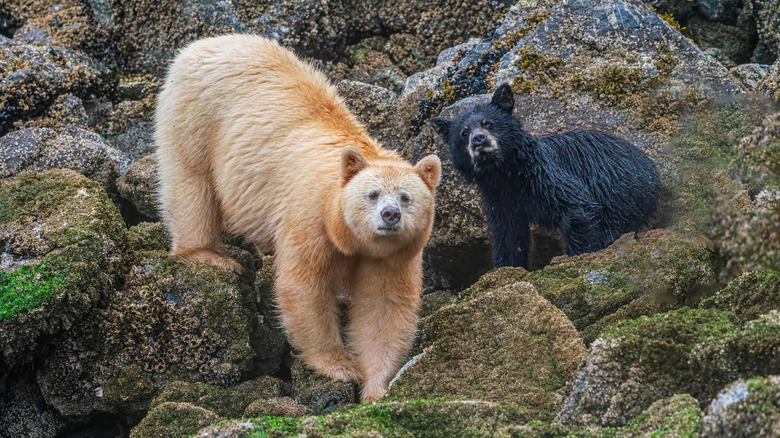This Canadian Destination Is Bucket List Worthy For The Chance To See A Rare Bear
Stretching over 250 milesalong the rugged British Columbia coastline, the Great Bear Rainforest stands as one of the last large temperate rainforests on the planet and is sometimes even called the "Amazon of the North." The area encompasses 1,000-year-old cedar forests along with stunning waterfalls and fjords and is home to an astonishing array of wildlife, including wolves, black and grizzly bears, deer, cougars, mountain goats, orca, salmon, sea lions, sea otters, and humpback whales.
But it's the elusive inhabitant known as the Kermode or spirit bear that truly steals the spotlight. The spirit bear is a sub-species of black bear that carries recessive genes for light coloring. Their bright creamy fur sets them apart from the dark landscapes of the forest, making them almost appear to glow. Given their mystical appearance, it's no wonder that some of the region's First Nation people consider the bears to be sacred beings. While their appearance may be somewhat ethereal, their size and speed are anything but: an adult spirit bear can weigh up to 350 pounds and run through the forest at speeds approaching 35 mph.
Spotting a spirit bear is the opportunity of a lifetime, as the creatures are found only in this part of the world and very few in number. Their exact population size is difficult to determine, but it's believed to be less than a few hundred bears, total. This makes the spirit bear one of the rarest creatures in the entire world.
Wildlife tours in the Great Bear Rainforest
Not all visitors who attempt to see a spirit bear in the Great Bear Rainforest will be successful, but the search can be an incredible adventure in itself. Tours with local indigenous guides are the best way to seek out the bears, and these experiences are also great ways to learn about the indigenous cultures of British Columbia. For example, Spirit Bear Lodge in Klemtu offers a variety of multi-day packages that include boat rides to and from the oceanfront lodge, rooms with ocean views, home-cooked meals, and opportunities to mingle with and learn from members of the Kitasoo Xai'xais First Nation, who own and manage the entire operation. Knowledgeable indigenous guides also run the wilderness tours, so you'll be in good hands if you happen to run into a bear while hiking.
Tours involve boat rides through the estuaries, where spirit and other bears can often be spotted feeding. At certain points during the journey, guests can disembark on the rocky shoreline to explore the coastal landscape on foot. The boat and hiking excursions provide opportunities to see many other forms of wildlife besides spirit bears, and Spirit Bear Lodge guides are mindful of employing ethical viewing practices at all times to ensure minimal disturbance to the animals.
Touring the coast in a kayak
Remote expedition kayak tours are another great way to explore the Great Bear Rainforest, for those who want to see bears and other wildlife in the most adventurous way possible. Spirit of the West Adventures offers multi-day kayak tours of the area starting in the town of Bella Bella, a 2.5-hour flight from Vancouver. Kayakers travel through the Hakai Passage and the Kildidt Sound in what the company refers to on its website as "one of the most stunning seascapes around," so glorious it's been the subject of numerous documentaries and publications. Nights are spent camping on beaches or in forest clearings, deep in the heart of the coastal wilderness.
While the Great Bear Rainforest can be visited year-round, the best time to catch a glimpse of the elusive Kermode bear is during the salmon spawning season from late August to mid-October, when these iconic creatures gather along rivers and streams to feast on the annual salmon run. For those who want to continue exploring British Columbia, Vancouver Island is a short ferry or plane ride away from Vancouver. Renowned for its pristine landscapes, it's another spectacular place for wildlife-watching adventures, with opportunities to see black bears, humpback whales, orcas, seals, and more.


